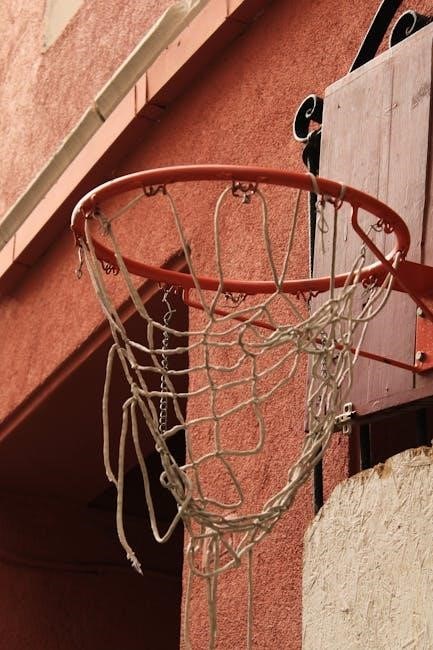Rust is a challenging multiplayer survival game where players gather resources‚ craft tools‚ and build bases in a harsh‚ post-apocalyptic world. The game demands strategic thinking and adaptability to survive against hunger‚ thirst‚ and hostile players. With its open-world exploration and intense PvP combat‚ Rust offers a unique blend of creativity and competition‚ making it a captivating experience for both newcomers and seasoned gamers alike.
What is Rust?
Rust is a multiplayer survival game developed by Facepunch Studios. Set in a post-apocalyptic world‚ it challenges players to gather resources‚ craft tools‚ and build bases while fending off hostile enemies and other players. The game emphasizes survival mechanics‚ such as managing hunger‚ thirst‚ and health‚ while also encouraging base construction and PvP combat. Rust offers a mix of creativity and competition‚ making it a popular choice for players who enjoy open-world exploration and strategic gameplay in a harsh‚ unforgiving environment.
The Core Gameplay Mechanics
Rust revolves around survival and base-building in a hostile world. Players gather resources like wood‚ stone‚ and metal to craft tools and construct bases. The game features a day-night cycle and weather system‚ adding depth to exploration and resource gathering. Crafting is essential for creating weapons‚ armor‚ and building materials. Players must manage hunger‚ thirst‚ and health‚ while defending against wildlife and other players. PvP combat is a central mechanic‚ with players able to raid or defend bases. The game rewards strategic planning‚ creativity‚ and adaptability‚ making it a challenging yet rewarding experience for survival enthusiasts.
Getting Started in Rust
Rust is a brutal survival game where players must gather resources‚ craft tools‚ and build shelter to survive. Starting with basic tools‚ you’ll progress to create weapons and bases‚ learning essential skills to thrive in the harsh environment. Understanding the core mechanics early ensures a smoother experience in this challenging world.
Choosing the Right Server for Beginners
Selecting the right server is crucial for new players in Rust. Opt for a low-population server to reduce competition and allow time to gather resources and learn mechanics. Servers labeled as “Just Wiped” or “Low Pop” are ideal‚ as they offer a fresh start and fewer experienced players. Avoid high-population servers‚ as they can be overwhelming for beginners. Additionally‚ consider joining a server with a friendly community or role-playing elements to enhance your learning experience and overall enjoyment of the game.
Gathering Essential Resources
Gathering resources is the foundation of survival in Rust. Start by collecting wood and stone using your rock or crafted tools. Prioritize wood for crafting basic items like a hatchet and pickaxe‚ which will increase your efficiency. Locate animals for food and water sources‚ but be cautious of contamination. Scavenge barrels and crates for valuable loot‚ and consider exploring monuments for advanced materials. Manage your inventory wisely‚ and as you progress‚ craft better tools to access higher-tier resources like metal. Efficient resource gathering is key to building‚ defending‚ and thriving in Rust’s challenging environment.
Building Your First Base
Building your first base in Rust is crucial for survival. Choose a safe location with nearby resources and flat ground. Start with a 2×2 foundation using wood or stone. Craft a Building Plan and place walls‚ floors‚ and a roof. Use a Door and Lock to secure your base. Keep it simple initially‚ upgrading materials later for better durability. Avoid building near cliffs or water to prevent damage. Ensure your base is well-lit and has storage for your items. This will serve as your sanctuary and crafting hub‚ essential for progression in the game.

Character Customization and Skins
Character customization is limited in Rust‚ but skins allow players to personalize their appearance. Skins enhance aesthetics and role-playing experiences without affecting gameplay. Obtain skins through trading or in-game purchases for a unique look in this survival world.
Can You Customize Your Character in Rust?
In Rust‚ character customization is extremely limited compared to other survival games. Players cannot customize their character’s appearance‚ as the game focuses more on survival mechanics and base-building rather than aesthetics. The default character models are fixed‚ and there are no options to change facial features‚ clothing‚ or other visual traits. However‚ skins purchased through in-game stores or trading with other players can alter your character’s appearance. These skins are purely cosmetic and do not provide any gameplay advantages. This lack of customization aligns with Rust’s core philosophy of prioritizing functionality over form.
The Role of Skins in Rust
Skins in Rust are cosmetic items that allow players to customize their weapons‚ armor‚ and tools without affecting gameplay mechanics. They serve as a way to personalize your gear‚ making it stand out in a survival environment dominated by utility. Skins can be purchased through in-game stores or obtained by trading with other players. While they don’t provide any functional advantages‚ they add a layer of visual uniqueness and can be valuable in role-playing scenarios or specific server settings. Skins have become a popular aspect of Rust’s community‚ enabling players to express their individuality in a game focused on survival and resource management.

Optimizing Your Game Experience
Optimizing Rust involves adjusting settings for better FPS and performance. Tweaking graphics‚ enabling console commands‚ and ensuring hardware compatibility can significantly enhance your gameplay experience and fluidity.
Best Settings to Increase FPS in Rust
To boost FPS in Rust‚ adjust your graphics settings by lowering shadow quality‚ texture filtering‚ and anti-aliasing. Reduce the view distance and shadow distance for better performance. Ensure your resolution matches your monitor’s native resolution and disable unnecessary effects like motion blur. For low-end PCs‚ consider turning off shadows entirely. Additionally‚ update your graphics drivers and close background programs to optimize performance. Experiment with these settings to find a balance between visual quality and smooth gameplay‚ ensuring a more enjoyable experience in Rust’s demanding environment.
Console Commands and How to Use Them
In Rust‚ console commands are essential for troubleshooting and enhancing gameplay. To access the console‚ press F1 and type your desired command. Useful commands include help to list all available commands‚ clear to reset your inventory‚ and ping to check server latency. Admins can use commands like teleport or remove to manage the server. Note that some commands require admin privileges and may vary between servers. Experiment with these tools to improve your Rust experience and resolve common issues efficiently.

Exploring the Map and Monuments
Mastering the map layout is crucial for survival‚ as each area offers unique resources and challenges. Monuments‚ with their puzzles‚ reward strategic exploration and skillful navigation.
Understanding the Map Layout
Understanding Rust’s map layout is crucial for survival. Each map is unique‚ featuring diverse biomes‚ from dense forests to barren deserts‚ each offering different resources and challenges. Roads and monuments serve as key landmarks‚ guiding players to valuable loot and potential threats. High ground provides visibility and defensive advantages‚ while rivers offer water sources. Familiarizing yourself with the terrain helps in locating essential resources‚ avoiding danger‚ and navigating efficiently. Knowing your surroundings is key to thriving in Rust’s unforgiving world.
Solving Monument Puzzles
Solving monument puzzles in Rust involves a mix of exploration‚ observation‚ and strategic thinking. Begin by thoroughly examining the environment for clues like symbols‚ numbers‚ or patterns on walls‚ which often guide the solution. Key cards or specific tools such as wrenches and screwdrivers may be required to unlock doors or interact with mechanisms. Approach puzzles methodically‚ using items found within the monument or its surroundings. Practice and familiarity with common puzzle types will enhance your problem-solving skills‚ helping you unlock rewards and progress through the game.
Advanced Base Building
Advanced base building in Rust involves using high-quality materials like metal fragments and stone for durability. Incorporate multi-level designs‚ traps‚ and automated defenses to enhance security and efficiency.
Securing Your Base
Securing your base in Rust requires a combination of strategic design and resource investment. Use high-quality materials like metal fragments and stone for walls and doors to withstand raids. Install metal doors‚ keycard systems‚ and turrets for enhanced protection.burying your base underground or in a secluded area can reduce visibility to enemies. Surround your base with traps and natural barriers to deter intruders. Regularly check for weaknesses and reinforce vulnerable points. Lighting can also help detect intruders at night. A well-secured base ensures your survival and protects your hard-earned resources in Rust’s unforgiving environment.
Traps and Defense Systems
Traps and defense systems are crucial for protecting your base in Rust. Use landmines‚ shotgun traps‚ and poison traps to deter raiders. Place traps strategically around your base perimeter and at entry points. Consider layering traps to create a multi-stage defense system. Electric fences and turrets can also be employed for automated defense. Ensure traps are well-hidden and baited with valuable items to lure intruders. While traps can be effective‚ they should complement a strong base design and active defense strategies. A well-designed trap system can save your base from potential threats in Rust’s competitive environment.
Combat and Survival Strategies
Rust requires mastering combat tactics‚ scavenging efficiently‚ and building robust bases. Adaptability and strategic thinking are key to thriving in this unforgiving survival environment.
Weapons and Armor Crafting
Crafting weapons and armor is crucial for survival in Rust. Start with basic tools like the rock and stone knife‚ then progress to crafted weapons such as bows and spears. Armor crafting begins with cloth or leather gear‚ providing essential protection early on. As you gather resources‚ upgrade to metal armor and advanced weapons like firearms. Crafting requires specific blueprints and materials‚ which can be found through scavenging or looting. Regularly upgrading your gear ensures better defense and combat effectiveness‚ making you more formidable against enemies and wildlife in the harsh Rust environment.
Tips for Effective Combat
Effective combat in Rust requires strategic positioning‚ resource management‚ and quick decision-making. Always use cover like walls or rocks to avoid taking unnecessary damage. Conserve ammo by aiming for headshots and using melee weapons when possible. Stay aware of your surroundings to spot enemies early and prepare for fights. Keep crafting materials handy to repair gear mid-combat. Learn from past mistakes to improve your tactics. Avoid engaging in unnecessary fights‚ especially early on‚ and prioritize self-preservation. Mastering these strategies will enhance your combat efficiency and survival chances in Rust’s unforgiving world.
Exploration and Scavenging
Exploration and scavenging are crucial in Rust‚ as they provide essential resources. Scavenge roads‚ monuments‚ and abandoned buildings for supplies. Farming barrels and crates can yield valuable loot‚ aiding survival and progression.
Best Locations for Scavenging
The best locations for scavenging in Rust include roads‚ monuments‚ and abandoned buildings. Roads often have barrels and loot crates filled with valuable resources. Monuments like power plants and warehouses contain high-tier loot but are risky due to player activity. Airfields and supermarkets are also prime spots for scavenging‚ offering tools‚ weapons‚ and medical supplies. Always prioritize safety and use tools like a scavenger bag to carry more loot efficiently. These locations are essential for gathering the resources needed to survive and thrive in Rust’s harsh environment.
Farming Barrels and Loot Crates
Farming barrels and loot crates is a key part of resource gathering in Rust. Barrels can be found along roads‚ near monuments‚ and in abandoned areas‚ often containing scrap‚ tools‚ or weapons. Loot crates‚ found in specific locations like airfields or supermarkets‚ offer higher-value items. To farm efficiently‚ focus on areas with high traffic or near monuments. Use a scavenger bag to carry more loot and avoid waste. Regularly checking these spots can provide consistent resources‚ aiding in crafting and base-building. This method complements scavenging and helps sustain long-term survival in Rust.
Multiplayer and Community
Rust’s multiplayer mode immerses players in a vibrant community‚ fostering interactions‚ alliances‚ and rivalries. Joining servers enhances the experience‚ allowing collaboration‚ competition‚ and shared survival challenges.
Joining or Creating a Server
Joining or creating a server in Rust opens up endless possibilities for multiplayer interaction. Players can choose from various server types‚ including PvP‚ PvE‚ and role-playing‚ each offering unique experiences. To join a server‚ simply browse the server list in-game and select one that suits your playstyle. For those interested in creating a server‚ Rust offers tools to customize settings‚ ensuring a tailored experience. Hosting a server allows you to set rules‚ manage players‚ and create a community that aligns with your vision‚ enhancing the overall survival experience.
Role-Playing and Community Engagement
Role-playing adds depth to Rust‚ enhancing immersion through character backstories and interactive scenarios. Players on role-playing servers collaborate‚ form alliances‚ and create dynamic stories. Community engagement thrives in Rust‚ with players often sharing tips‚ strategies‚ and resources. Joining server hubs or participating in events fosters camaraderie and shared goals. Skins and customization options further support role-playing‚ allowing players to express their unique identities. Engaging with the community enriches the survival experience‚ turning Rust into more than just a game—it becomes a living‚ breathing world shaped by its players.

Advanced Tips and Tricks
Rust’s advanced strategies include mastering efficient resource farming‚ optimizing base security‚ leveraging combat tactics‚ and adapting to dynamic server environments. These techniques help dominate the game world.
Isolation Strategy for Progression
Isolation is a key strategy in Rust‚ focusing on establishing a secluded base in resource-rich areas. This approach minimizes interactions with hostile players‚ allowing uninterrupted progression. By basing in remote locations‚ players can gather materials‚ craft essential items‚ and build a strong foundation without constant threats. However‚ isolation requires careful planning to ensure proximity to vital resources and efficient base design. This method is ideal for solo players or those seeking to avoid early-game conflicts‚ enabling steady growth and preparation for future challenges in Rust’s unforgiving world.
Mixing Tables and Crafting Recipes
Mixing tables are essential for advanced crafting in Rust‚ enabling players to create complex items like explosives‚ ammo‚ and high-tier tools. Crafting recipes require specific combinations of resources‚ and understanding these is crucial for progression. From crafting basic items like stone arrows to advanced gear‚ mixing tables unlock new possibilities. Players must experiment with different resource combinations to master recipes‚ optimizing their crafting efficiency. This system adds depth to Rust’s survival mechanics‚ rewarding creativity and resource management. Mastering mixing tables is key to equipping yourself for both combat and base-building challenges in the game.





